ABSTRACT
Background
The present study deals the biological property of a medicinal plant, Peristrophe bicalyculata. This is a common herb used for a number of ailments ethno-pharmacologically. In the present study, the antioxidant, anti-inflammatory and anti-cancer activity of the ethyl acetate extract of P. bicalyculata was reported.
Materials and Methods
After collecting the plants from nearby hills of Chengalpattu, Tamil Nadu, the aerial part was washed and dried. The ethyl acetate extract of the plant was prepared using maceration method studied for its anti-oxidant, anti-inflammatory and cytotoxic activities.
Results
Results revealed that the extract can able to scavenge the radicles at the IC50 value of 33.96 µg/mL. Similarly, the anti-inflammatory activity also revealed that IC50 value of protein denaturation assay and HRBC membrane stabilization assay was 125 µg/mL and 41.5 µg/mL respectively. In lung cancer cell line A549, 62.57% of the cell death was observed at 1000 µg/mL. Ao/EtBr staining reveals cell death is mainly due to apoptosis and necrosis was less observed.
Conclusion
The study concludes that the plant has potential anticancer activity. Further studies on the bioactive compound behind the activity and their mechanism will provide a clear insight.
INTRODUCTION
Medicinal plants are used from ancient times in treating many ailments. A medicinal plant possesses many chemicals and essential oils which show different therapeutic properties. This therapeutic property has to scientifically evaluated to commercialize the medical property of as a drug (Sofowara et al., 2013). Pharmaceutical companies are glancing in to the medicinal plants for the interesting compounds with potent therapeutic activity and less side effects. WHO stated, 80% of the population in the universe are trusted on the medicinal plants to cure many ailments before visiting the physicians (Ayeet al., 2019). Searching for drug from medicinal plant should be carried out to develop a useful drug which might be from unexplored plants also. Therefore, many labs are focusing on the primary screening of the therapeutic property from the crude extract of the medicinal plant which helps to develop the potent drug in treating disease (Farnsworthet al., 1985). In the present study one such medicinal plant Peristrophe bicalyculata is chosen to explore the antioxidant, anti-inflammatory and anti-cancer activity in the crude extract.
Peristrophe bicalyculata (synonym Dicliptera paniculata, (Forssk.) I. Darbysh) is a common herb used for a number of ailments ethno-pharmacologically. This plant is also called as Goddess of Mercy This plant is widely disseminated from tropical Africa to India (Abdulazeezet al., 2022). The herb has expectorant, analgesic, anti-inflammatory, antipyretic, antibacterial, anti-hypertensive and anti-cancer properties. It is also used to cure snake poisoning, bone fracture, sprain, fever, cold and for ear and eye ailments (Reshmi et al., 2010). The anti-bacterial properties of this plant were studied against various pathogens affecting the respiratory tract and chloroform extract showed best antimicrobial activity than the other extract (Arya, 2018). The ameliorative property against the parasitic disease of P. bicalyculata was studied in the rats infected by Trypanosoma brucei (Abimbolaet al., 2013). Ogunwandeet al., 2010 also have reported the essential oil constituents and their biological roles of this plant (Ogunwandeet al., 2010). In the present study, the antioxidant, anti-inflammatory and anti-cancer activity of the ethyl acetate extract of P. bicalyculata was reported.
MATERIALS AND METHODS
Extraction of plant
Collection of Peristrophe bicalyculata plant was carried out from the hilltop at Chengalpattu, Tamil Nadu. After getting authentication from the Botanist the aerial parts of the plant were separated and shade dried. Using the maceration procedure, ethyl acetate extract was prepared. After 48 hr, extract was evaporated and the dried extract was used for further analysis.
Antioxidant studies
ABTS Radical Scavenging activity
7.4 mM of ABTS was incubated with 2.6 mM of Potassium persulfate was incubated for 16 hr which helps in the generation of free radical 2,2-azinobis-(3-ethylbenzothiazoline-6-sulfonic acid) (ABTS•+). The absorbance was measured at 734 nm after incubating 16 hr. Dilute the samples with methanol, until the absorbance reaches 0.706±0.001 at 734 nm. After the dilution process, 3.9 mL of ABTS•+ was mixed with 100 µL of the plant extract at different concentrations (25, 50, 100, 250, 500 and 1000 µg/mL). Sharply after 6 min, the absorbance was measured at 734 nm (Vijayamuthuramalingamet al., 2017). The percentage of inhibition was calculated using the formula
To compare the results with the standard, Ascorbic acid was used.
Reducing power capacity
This experiment is based on the property to reduce ferric (III) to ferrous (II) by the compounds present in the plant extract (Vijayamuthuramalingamet al., 2017). Various concentration of the samples from 25-1000 µg/mL of 1 mL was mixed with 2.5 mL of phosphate buffer (0.2 M, pH=6.6) and 2.5 mL of 1% potassium ferricyanide were added and incubated at 50ºC for 20 min. To stop the reaction after the incubation, 2.5 mL of 10% TCA was added. Equal volume of the distilled water was added to dilute the samples. Followed this 0.1% FeCl3 was added and allowed to stand for 10 min. Optical density was measured at 700 nm. Vitamin C was used as the standard.
Anti-inflammatory studies
Inhibition of Protein Denaturation
Following homogenization with 1 mL of an aqueous solution of Bovine Serum Albumin (BSA) (5%), various concentrations (100, 200, 500, and 1000 μg/mL) of plant extracts or diclofenac sodium was incubated at 27ºC for 15 min. The control tube was made up of distilled water and BSA. Protein denaturation was achieved by subjecting the mixture to a 10-min water bath at 70ºC. The mixture was maintained at room temperature, and each mixture’s activity was measured at 660 nm (Djuichouet al., 2019). Every test was administered thrice. The inhibition % was computed using the following formula:
HRBC membrane stabilization assay
An equal volume of sterilised Alsiever medium (2% (w/v) dextrose, 0.8% sodium citrate, 0.5% citric acid, and 0.42% sodium chloride in water) was combined with the drawn blood. After centrifuging the blood again for 10 minutes at 3000 rpm, the packed cells were cleaned with saline (pH 7.2, NaCl 0.9%), and then 10% (v/v) solution was prepared using saline. The plant extract, 1 mL phosphate buffer (0.15 M, pH 7.4), 2 mL saline (0.36%), and 0.5 mL HRBC solution were all included in the assay combination. Diclofenac served as the benchmark medication. The control was 2 mL of distilled water rather than hyposaline. The test concoctions were centrifuged at 3000 rpm for 10 min after incubated at 37ºC for 30 min (Parameswariet al., 2019). Optical Density was measured at 560 nm and the hemolysis % was calculated using the equation:
Anticancer activity of the extract
MTT assay
To study the anticancer activity, A549 lung cancer cell line was used. The cells were maintained in the Co2 incubator at 37ºC. The healthy cells were seeded in 96 well plate at 103 cell density. Once the cells reached the confluency, various concentration of extract was treated to the cells. After the 24 hr of incubation period, the plates were taken and removed the media and washed with PBS. The cells were treated with 20 µL of MTT and incubated further for 2 hr. After the incubation period, the formed formazon crystals were dissolved with DMSO and measured the absorbance at 570 nm
Ao/EtBr staining
The cells were grown in the 6 well plate with the density of 5×105 cells per well and incubated. Once confluent, the cells were treated with the extract at the concentration of 500 and 1000 µg/mL. After 24 hr of incubation period, media was removed, washed with PBS and then 10 µl of 1 mg/mL concentration of Acridine Orange (AO) and Ethidium Bromide (EtBr) was added in the six well plate containing PBS. The samples were visualized using flouresence microscope in triple filter and observed for the apoptotic and necrotic changes.
RESULTS
Yield of extraction
The cold maceration of the plant powder with ethyl acetate solvent was dehydrated and the percentage of yield was calculated as 6.2%.
Study on Antioxidant activity of the plant
ABTS radical scavenging assay
Two techniques were used to assess the plant’s antioxidant activity namely the reducing power activity and the ABTS radical scavenging assay. The extract improved the free radical scavenging activity of ABTS* in a dose-dependent manner. 33.96 µg/mL is the extract’s IC50 value for scavenging the ABTS radical (Figure 1a).
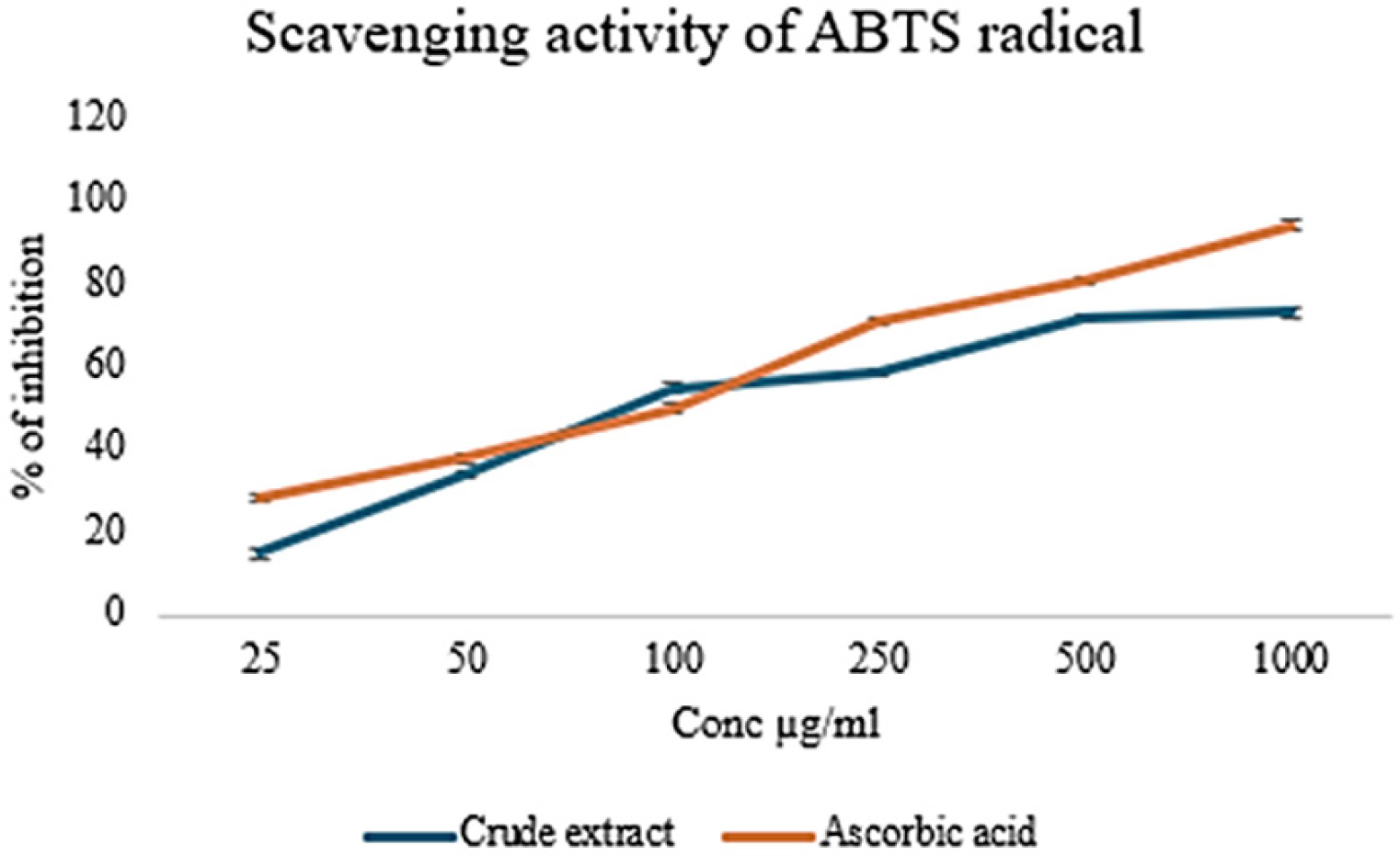
Figure 1a:
ABTS* radical scavenging activity of the extract: Showing dose-dependent inhibition of oxidative stress with increase in concentration of the extract with ascorbic acid as standard.
Reducing Power assay
Reducing capability of the extract was studied on how the compounds present in the extract have the capability to reduce the Fe3+ (ferricyanide complex) and form the Fe2+ (ferrous compound). The extract showed potent reducing power activity with the absorbance of 0.733±0.0001 at 1 mg/mL. The standard ascorbic acid showed absorbance of 0.91±0.0004 at 1 mg/mL (Figure 1b).
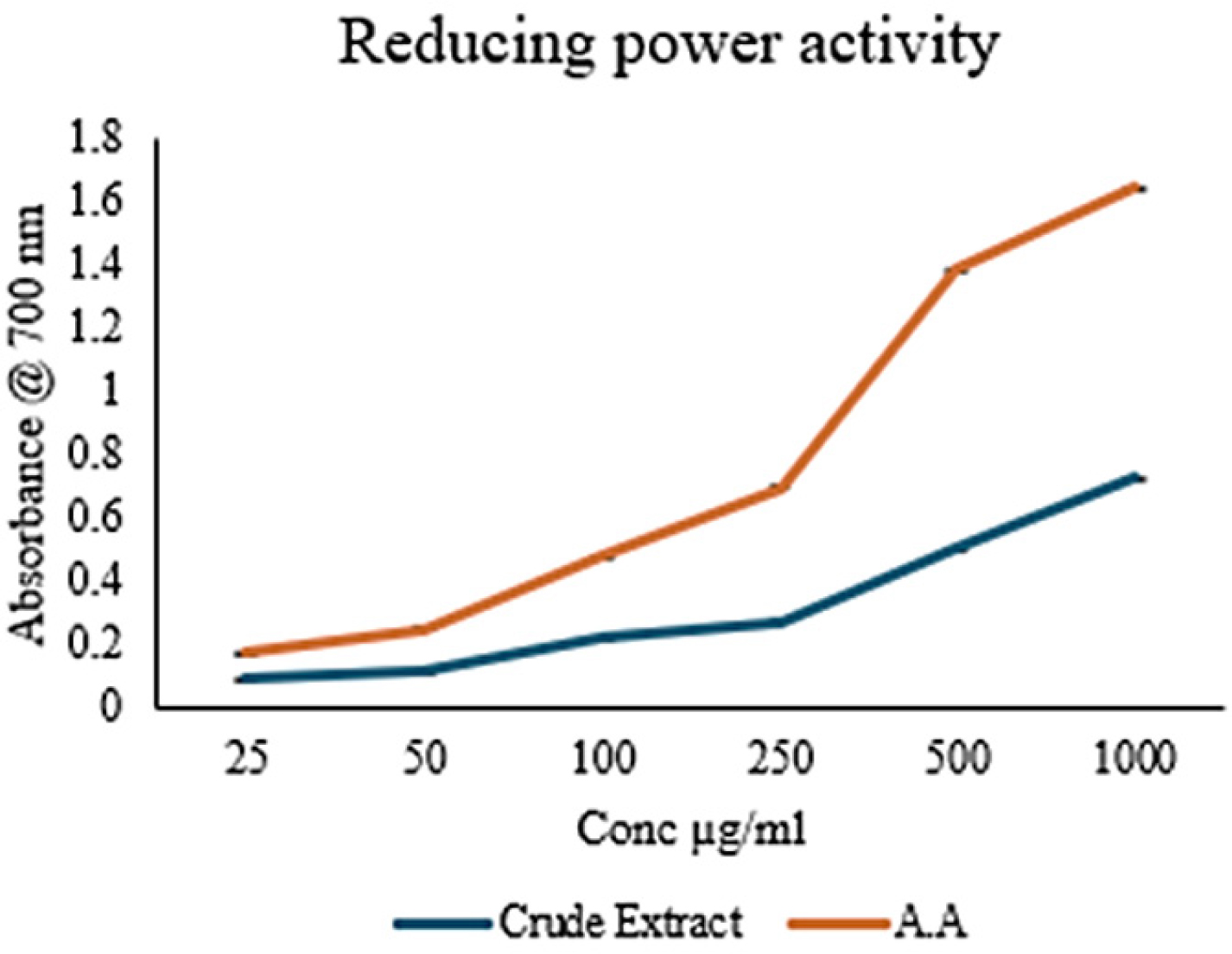
Figure 1b:
Reducing power activity of the extract: Showing dose- dependent inhibition with increase in extract concentration and ascorbic acid as standard.
Anti-inflammatory property
In vitro inhibition of inflammation pathway was studied by two methods namely by protein denaturation inhibition process and inhibition of RBC lysis. The extract inhibited the protein denaturation process with the IC50 value of 41.5 µg/mL (Figure 1c). The standard drug showed the inhibitory activity with the IC50 value of 5.16 µg/mL. Similarly, the RBC lysis was inhibited with increasing concentration of the extract. At the concentration of 1000 µg/mL, 82% inhibition of RBC lysis was observed (Figure 1d).

Figure 1c:
Protein denaturation assay of the extract: Showing dose- dependent inhibition of inflammatory action with the IC50 value of 41.5 µg/mL comparing to the standard.
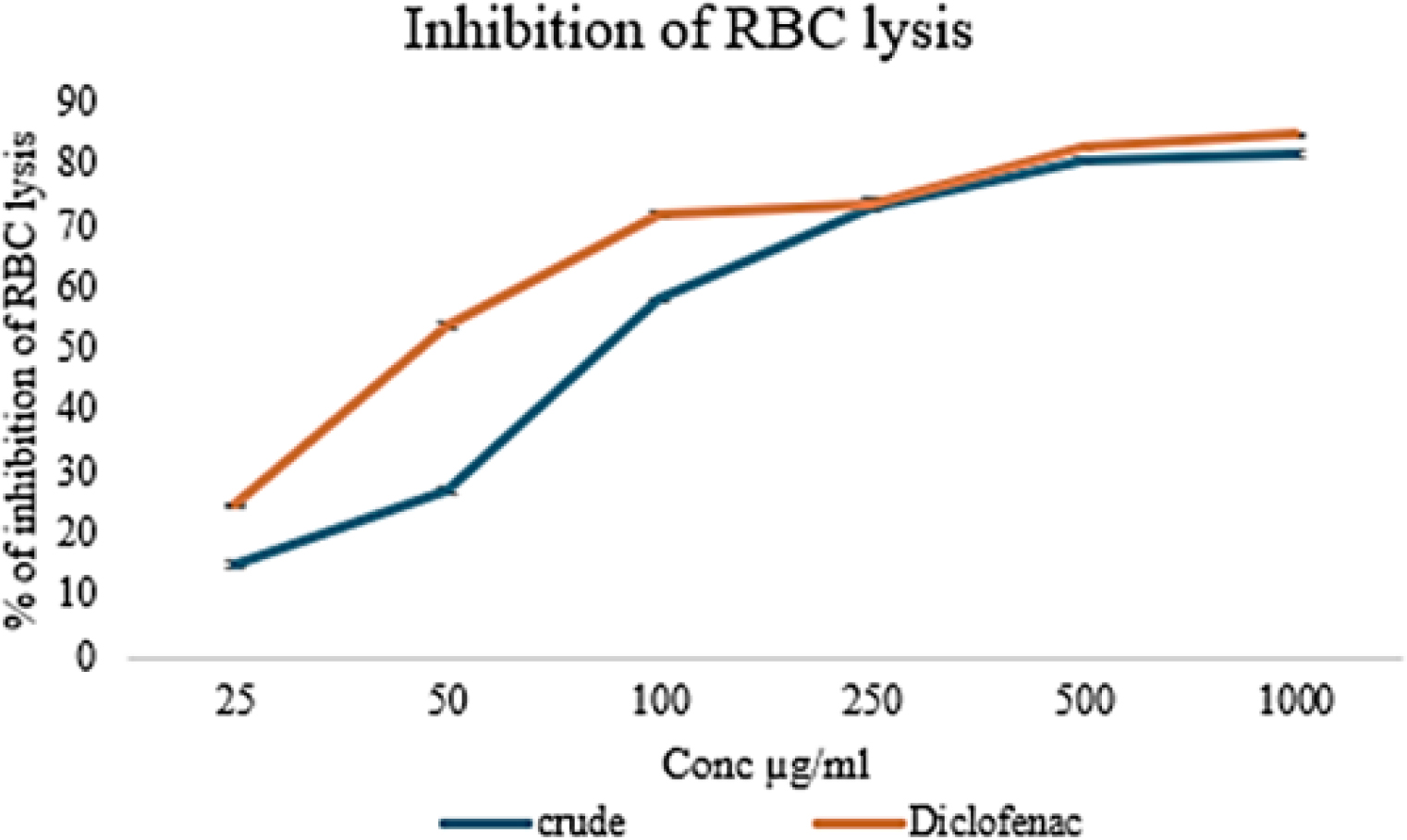
Figure 1d:
Inhibition of RBC lysis by the extract: Showing dose- dependent inhibition of RBC lysis with increase in concentration with the IC50 value of 5.16 µg/mL.
Anticancer activity of the extract
MTT assay
To study the anticancer activity, A549 lung cancer cell line was used. At 1000 µg/mL the 62.57% of the cell death was observed. In the phase contrast images, the cell morphology was changed and the cell density was reduced when compared to that of control (Figure 2a).
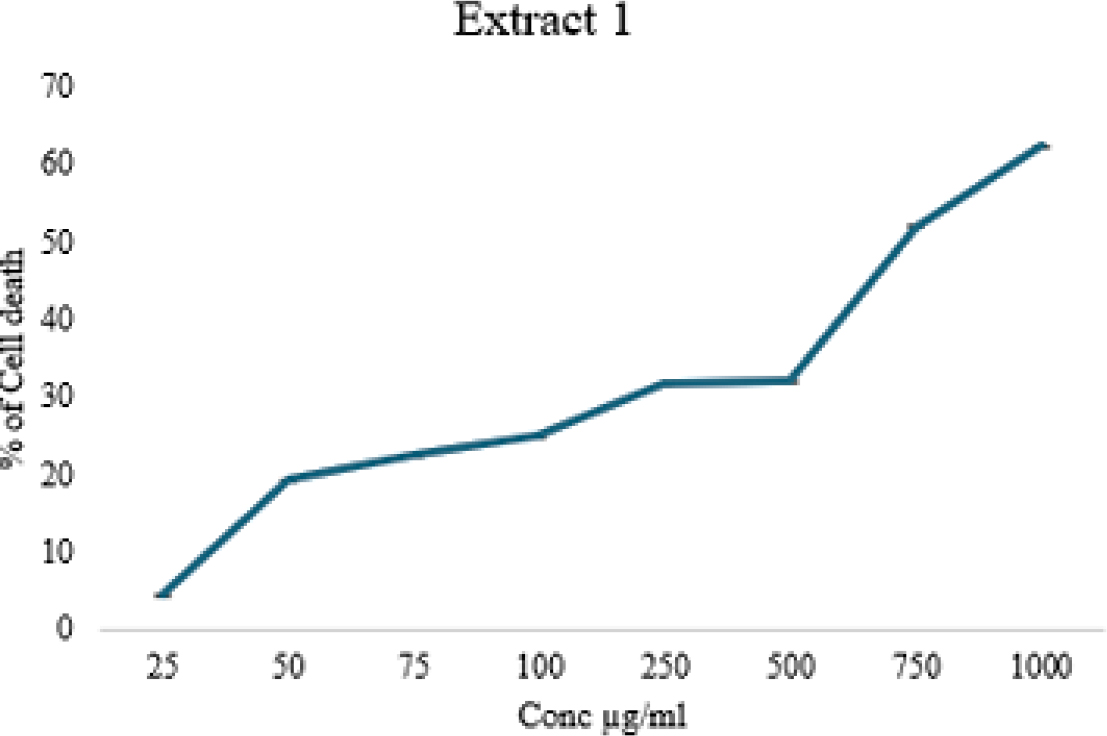
Figure 2a:
MTT cell viability assay: Dose- dependent cell death was observed in crude extract treated A549 cell line with increase in concentration. The concentration of the extract is in X- axis and the % of cell death is in Y-axis.
Ao/EtBr staining
In the control group, all the cells have a uniform morphology. In the extract treated group at the concentration of 500 µg/mL few cells lost its morphology and crescent shaped nucleus was observed. Cells treated with 1000 µg/mL showed more no of apoptotic cells was observed (Figure 2b).
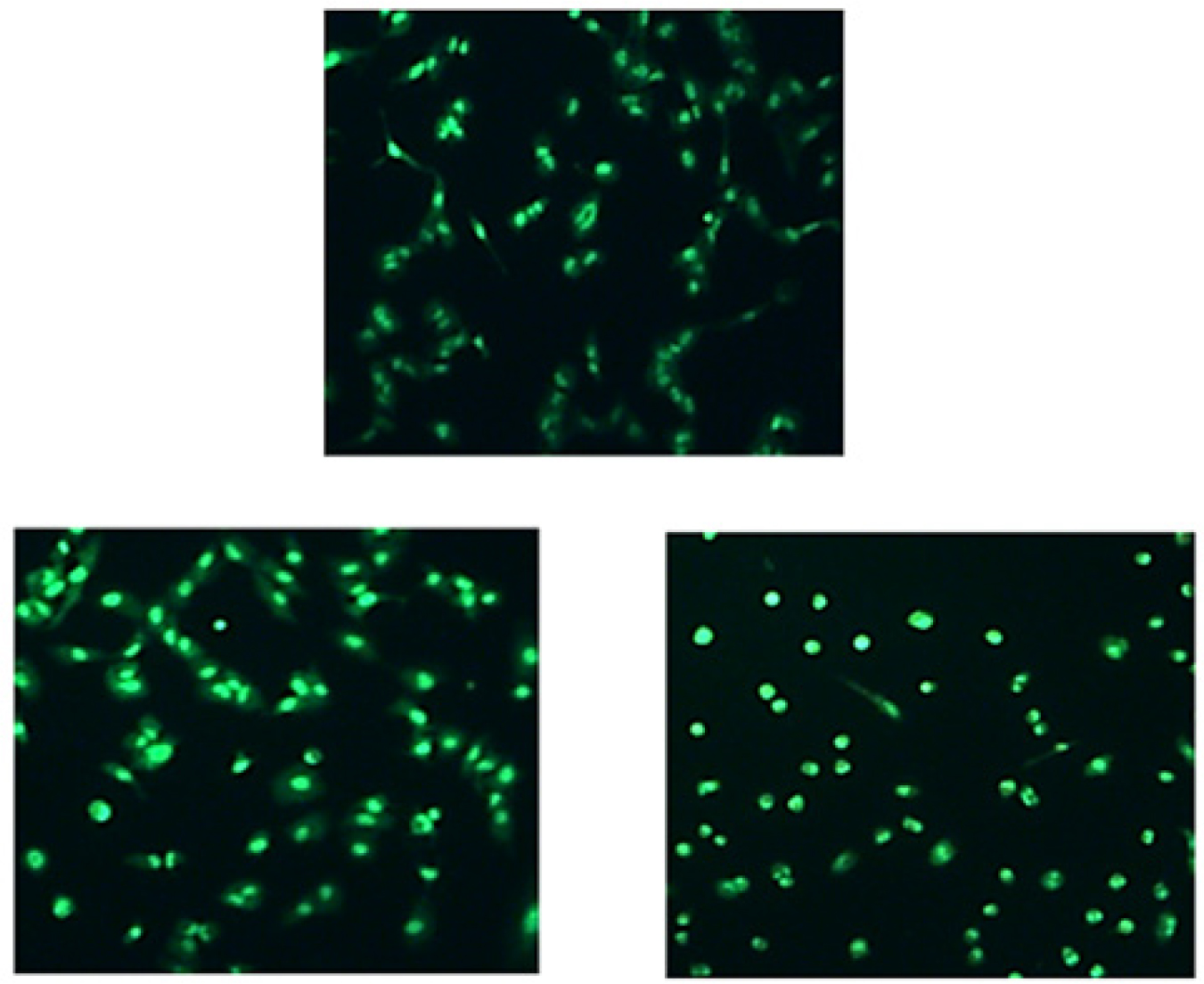
Figure 2b:
Ao/EtBr staining: Reveals the presence of apoptotic and necrosis morphology in the cells at different concentration.
DISCUSSION
Medicinal plants possess various bioactive compounds but the extraction protocol plays a vital role in the development of novel drugs. To analyse the types of compounds present in the samples, analytical tools such as GC-MS can be performed (Gomathiet al., 2015). The results of the GC-MS analysis of the aerial parts of Peristrophe bicalyculata ethyl acetate extract, along with the possible medicinal role of each molecule of Peristrophe bicalyculata extract are tabulated in Table 1. Previous study showed the presence of seven bioactive compounds GC-MS analysis of ethanolic extract (Narayanan et al., 2012). In the current study, 17 compounds with potent therapeutic value were present in the ethyl acetate extract. The difference in the number of compounds between two study is mainly due to the solvent used in the extraction process (Hashmi et al., 2013).
| Ret. Time | Name of the Compound | Mol. Mass | Mol. Formula | % Peak area | Possible medicinal Properties |
|---|---|---|---|---|---|
| 4.08 | Benzene, 1-ethynyl-4-fluoro- | 120 | C8H5F | 13.78 | Not known |
| 4.18 | Pyrrolidine, 2-butyl-1-methyl- | 141.2 | C9H19N | 29.45 | Catechol-O-Methyl-Transferase-Inhibitor, Catechol-O-Methyltransferase-Inhibitor, Methyl-Donor, Methyl-Guanidine-Inhibitor |
| 5.18 | trans-Traumatic acid | 228.1 | C12H2OO4 | 0.34 | Catechol-O-Methyl-Transferase-Inhibitor, Decreases Glutamate Oxaloacetate Transaminase, Decreases Glutamate Pyruvate Transaminase, Glucosyl-Transferase-Inhibitor, Glutathione-S-Transferase-Inhibitor, Increase Glutathione-S-Transferase (GST) Activity, Increases Glyoxalate Transamination, Reverse-Transcriptase-Inhibitor, Transdermal, Acidifier, Acidulant, Arachidonic acid-Inhibitor, Arachidonic-Acid-Inhibitor, Increases Aromatic Amino Acid Decarboxylase Activity |
| 5.30 | .alpha.-D-Glucopyranoside,O-.alpha.-D-glucopyranosyl- (1.fwdarw.3)-.beta.-D-fructofuranosyl | 504.2 | C18H32O16 | 10.76 | 5-Alpha-Reductase-Inhibitor, Alpha-Agonist, Alpha-Amylase-Inhibitor, Alpha-Glucosidase-Inhibitor, Alpha-Reductase-Inhibitor, HIF-1alpha-Inhibitor, IkappaB-alpha-Phosphorylation-Inhibitor, Increase Alpha-Activity, Interleukin-1-alpMannosidase ha-Inhibitor, Testosterone-5-Alpha-Reductase-Inhibitor, TNF-alpha-Inhibitor, Aldehyde-Oxidase-Inhibitor, Anticancer, Antidote, Antiretinitic, Antitumor, Catechol-O-Methyl-Transferase-Inhibitor, Catechol-O-Methyltransferase-Inhibitor, Increases Osteocalcin |
| 5.56 | [1-(3,3-Dimethyloxiran-2-ylmethyl)-3,7-dimethylocta-2,6- dienyl]trimethylsilane | 294.2 | C18H34OSi | 0.52 | NK |
| 5.98 | 1,2,3,5-Cyclohexanetetrol, (1.alpha.,2.beta.,3.alpha.,5.beta.)- | 148.1 | C6H12O4 | 22.70 | NKs |
| 6.12 | l-Gala-l-ido-octonic lactone | 238.1 | C8H14O8 | 2.15 | Beta-Galactosidase-Inhibitor, Galactagogue, 12-Lipoxygenase-Inhibitor, 5-Lipoxygenase-Inhibitor, Anti-LDL, Anticancer, Anticarcinomic, AntiCorpus-Luteum, Antidote, Antitumor, Benzodiazepine-Receptor Ligand |
| 6.14 | cis-10-Heptadecenoic acid | 268.2 | C17H32O2 | 2.50 | Acidifier, Acidulant, Arachidonic acid-Inhibitor, Increase Aromatic Amino Acid Decarboxylase Activity, Inhibits Production of Uric Acid, |
| 6.29 | trans-13-Octadecenoic acid | 282.3 | C18H34O2 | 5.83 | Catechol-O-Methyl-Transferase-Inhibitor, Decreases Glutamate Oxaloacetate Transaminase, Decreases Glutamate Pyruvate Transaminase, Glucosyl-Transferase-Inhibitor, Glutathione-S-Transferase-Inhibitor, Increase Glutathione-S-Transferase (GST) Activity, Increases Glyoxalate Transamination, Reverse-Transcriptase-Inhibitor, Transdermal, Acidifier, Acidulant, Arachidonic acid-Inhibitor, Increases Aromatic Amino Acid Decarboxylase Activity, Inhibit Production of Uric Acid |
| 6.34 | 12-Hydroxy-14-methyl-oxa-cyclotetradec-6-en-2-one | 240.2 | C14H24O3 | 1.15 | Decrease Glutamate Oxaloacetate Transaminase, Decreases Oxalate Excretion, Low Oxalate, Decreases Endothilial Leukocyte Adhesion, Decreases Endothilial Platelet Adhesion, Encephalopathic, Endocrinprotective, Endorphinogenic, Endothelium-Dependent, Endothelium-Derived Relaxing Factor Promoter, Energizer, Enterocontractant |
| 6.66 | D-Mannoheptadecane-1,2,3,4,5-pentaol | 320.3 | C17H36O5 | 0.34 | ‘Smart-Drug’, 17-beta-hydroxysteroid dehydrogenase-Inhibitor, Alcohol-Dehydrogenase-Inhibitor, Anticancer , Antidote Antileukotriene-D4, Circulatory-Depressant, CNS-Depressant, Coronary-Dilator, Cyclin-D1-Inhibitor, , Decalcifier, Decarboxylase-Inhibitor, Decongestant, Decreases C-Teleopeptide Excretion, Decrease Deoxypyridinoline Excretion, Decreases Endothilial Leukocyte Adhesion, Decreases Endothilial Platelet Adhesion |
| 6.84 | D-chiro-Inositol, 3-O-(2-amino-4-((carboxyiminomethyl)amino)- 2,3,4,6-tetradeoxy-.alpha.-D-arabino-hexopyranosyl)- | 379.2 | C14H25N3O9 | 2.26 | NK |
| 6.87 | 1,2,3,4,5-Cyclopentanepentol | 150.1 | C5H10O5 | 0.65 | NK |
| 6.94 | Octanoic acid, 2-methyl- | 158.1 | C9H18O2 | 5.29 | Catechol-O-Methyl-Transferase-Inhibitor, Catechol-O-Methyltransferase-Inhibitor, Methyl-Donor, Methyl-Guanidine-Inhibitor, Acidifier, Acidulant, Arachidonic acid-Inhibitor, Arachidonic-Acid-Inhibitor, Increase Aromatic Amino Acid Decarboxylase Activity. Inhibit Production of Uric Acid, Urinary-Acidulant, Urine-Acidifier |
| 7.15 | 11-Bromoundecanoic acid | 264.1 | C11H21BrO2 | 0.78 | Acidifier, Acidulant, Arachidonic acid-Inhibitor, Arachidonic-Acid-Inhibitor, Increase Aromatic Amino Acid Decarboxylase Activity, Inhibit Production of Uric Acid, Urinary-Acidulant, Urine-Acidifier |
| 8.15 | Methyl stearate | 298.3 | C19H38O2 | 3.80 | Catechol-O-Methyl-Transferase-Inhibitor, Catechol-O-Methyltransferase-Inhibitor, Methyl-Donor, Methyl-Guanidine-Inhibitor |
| 8.65 | Benzeneethanamine, 2-fluoro-.beta.,3,4-trihydroxy-N-isopropyl- | 229.1 | C11H16FNO3 | 1.53 | 17-beta-hydroxysteroid dehydrogenase-Inhibitor, Antiamyloid-Beta, AntiTGF-beta, Beta-2-Receptor-Agonist, Beta-Adrenergic Receptor Blocker, Beta-Andrenergic-Agents, Beta-Blocker, Beta-Galactosidase-Inhibitor, Beta-Glucuronidase-Inhibitor, ER-Beta-Binder, Anaphylactic, Antitumor, Arylamine-N-Acetyltransferase-Inhibitor, Decreases Norepinephrine Production, Down regulates of nuclear and cytosol androgen reuptake, GABA-nergic, Increases Natural Killer (NK) Cell Activity, Inhibits Production of Tumor Necrosis Factor |
| 10.57 | 9,12,15-Octadecatrienoic acid, 2-[(trimethylsilyl)oxy]-1- [[(trimethylsilyl)oxy]methyl]ethyl ester, (Z,Z,Z)- | 496.3 | C27H52O4Si2 | 0.52 | NK |
| 24.30 | Heptasiloxane, 1,1,3,3,5,5,7,7,9,9,11,11,13,13-tetradecamethyl- | 504.2 | C14H44O6Si7 | 0.84 | NK |
To study the therapeutic property of the ethyl acetate extract, antioxidant, anti-inflammatory and cytotoxic activity was studied. Synthesis of free radicals in the human system can pave the way to the development of various diseases. Scavenging of free radical by the medicinal plant in addition with different therapeutic property will helps to impede the progression of diseases (Diazet al., 2012). The current study assessed the free radical scavenging activity of the extract ABTS and reducing power assay. In a previous study, ethyl acetate extract showed the percentage of inhibition at the concentration of 1000 µg/mL was 55.45% to scavenge the DPPH radical (Arya and Metha., 2017). The result in the present study showed percentage of inhibition at the concentration of 1000 µg/mL was 73% to scavenge the ABTS radical. Iron is one of the important free radicals which reacts with macro molecules like lipid and generate lipid peroxidation (Giotiet al., 2009).
Chelating the iron is very important antioxidant property and in the present study the chelating property of the crude extract was observed. Apart from antioxidant activity, significant in vitro anti-inflammatory was observed in this study by two methods namely protein inhibition assay and RBC lysis inhibition assay. Human RBC cells and lysosomes membranes are similar in structure and function and during the inflammation process, lysosome membrane stabilization is very important to pervert the further progression of inflammation (Saleemet al., 2011). In the present study, the stabilization of human RBC membrane was maintained by the crude extract of Peristrophe bicalyculata. Another mechanism of inflammation prevention is by inhibiting the protein denaturation. Denaturation of protein increases the production of auto antigens and increases the autoimmune disorders like rheumatic arthritis (Dharmadevaet al., 2018). In the present study, crude extract inhibits the denaturation of protein caused by heat. Thus, the extract possesses anti-inflammatory activity by reducing the denaturation of protein and stabilizing the human RBC cells.
Apart from these biological activities, cytotoxic activity against cancer cells was also studied against lung cancer cell, A549. MTT assay is one of the consistent methods followed by many researchers to measure the cell viability (Ogboleet al., 2017). Cytotoxic activity against the cancer cell line and the normal cell line is the preliminary screening to study the anticancer properties (Nemati et al., 2015). Ethyl acetate extract showed 62.57% cell viability measured by MTT assay.
Previous studies describe the anticancer activity of the leaf extract of this plant in cervical and foetal lung cancer cell line (Abdulazeezet al., 2022). The current study was carried out in lung cancer cell line A549. To study the mechanism of cell death induced by the extract, A549 cells treated with Acridine orange and ethidium bromide stains. These two stains help to reveal the presence of apoptotic and necrotic cell population in the treated cells (Liuet al., 2015). Staining of cell with Ao/EtBr also reveals that the extract induces apoptosis in the cell line. Further study in this extract will give the insights about the anti-cancer and anti-inflammatory activity of the plant.
CONCLUSION
Peristrophe bicalyculata is one of the important medicinal plants used in the traditional system of medicine. Though it has various therapeutic properties, scientific evidences were lacking. This study showed the ethyl acetate extract of aerial plant possess the various therapeutic properties including antioxidant, anti-inflammatory and cytotoxic activities. Further work has to be carried out to understand the molecular mechanism is warranted.
Cite this article:
Lakshmisundaram R, Kalaivani MK, Muruganandham L, Baskaran KPR, Muniyandi D, Rao MRK. Biological Profiling and Phytochemical Analysis of Peristrophe bicalyculata: Evaluating its Therapeutic Potential and Active Compounds. J Young Pharm. 2025;17(3):571-80.
ACKNOWLEDGEMENT
The authors want to acknowledge the management for providing facility.
ABBREVIATIONS
| GC-MS | Gas Chromatography- Mass Spectrometry |
|---|---|
| IC50 | Maximum Inhibitory Concentration |
| MTT | 3 -(4,5-dimethylthiazol-2-yl)-2,5-diphenyltetrazolium bromide |
| Ao/EtBr | Acridine Orange/Ethidium Bromide |
| ABTS | 2,2’- azino- bis(ethylbenzothiazoline-6-sulfonic acid) |
| DPPH | 2,2- diphenyl- 1- picrylhydrazyl |
| WHO | World Health Organization |
| HRBC | Human Red Blood Cell |
| PDB | Protein Data Bank |
| PBS | Phosphate- Buffered Saline |
| DMSO | Dimethyl Sulfoxide |
| EGFR | Epidermal Growth Factor Receptos |
| VEGF | Vascular Endothelial Growth Factor |
| PDL | Programmed Death Ligand |
| KRAS | Kristen Rat Sarcoma Virus. |
References
- Abdulazeez M. A., Ibrahim S., Amhe D. A. (2015) Bioassay guided fractionation and antihypertensive properties of fractions and crude extracts of P. bicalyculata. Acta Poloniac Pharmaceutica-Drug Research 7: 319-328 Google Scholar
- Abdulazeez M. A., Jasim H. A., Bashir M., Ross K., Fatokun A. A.. (2022) Peristrophe bicalyculata (Retz) Nees contains principles that are cytotoxic to cancer cells and induce caspase-mediated, intrinsic apoptotic death through oxidative stress, mitochondrial depolarisation and DNA damage. Biomedicine and Pharmacotherapy 147: Article 112597 https://doi.org/10.1016/j.biopha.2021.112597 | Google Scholar
- Abimbola A. M., Baba I. A., Yenusa E. Z., Omanibe S. J., Oladimeji I. H.. (2013) Anti-trypanosomal effect of extract on brucei-infected rats. Asian Pacific Journal of Tropical Biomedicine 3: 523-531 https://doi.org/10.1016/S2221-1691(13)60107-0 | Google Scholar
- Al Hashmi L. S., Hossain M. A., Weli A. M., Al-Riyami Q., AlSabahi J. N.. (2013) Gas chromatography-mass spectrometry analysis of different organic crude extracts from the local medicinal plant of L. Asian Pacific Journal of Tropical Biomedicine 3: 69-73 https://doi.org/10.1016/S2221-1691(13)60026-X | Google Scholar
- Arya P.. (2018) Antioxidant, phytochemical and antibacterial action of Himalayan medicinal herbs leaves extract against respiratory tract pathogens. International Journal of Pharmacy and Pharmaceutical Sciences 10: 16-21 https://doi.org/10.22159/ijpps.2018v10i3.23961 | Google Scholar
- Arya P., Mehta J. P.. (2017) Antioxidant potential of Himalayan medicinal plants and . International Journal of Current Microbiology and Applied Sciences 6: 1892-1901 https://doi.org/10.20546/ijcmas.2017.607.226 | Google Scholar
- Aye M. M., Aung H. T., Sein M. M., Armijos C.. (2019) A review on the phytochemistry, medicinal properties and pharmacological activities of 15 selected Myanmar medicinal plants. Molecules 24: 293 https://doi.org/10.3390/molecules24020293 | Google Scholar
- Dharmadeva S., Galgamuwa L. S., Prasadinie C., Kumarasinghe N.. (2018)
In vitro anti-inflammatory activity of Ficus racemosa L. bark using albumin denaturation method. AYU (An International Quarterly Journal of Research in Ayurveda) 39: 239-242 https://doi.org/10.4103/ayu.AYU_27_18 | Google Scholar - Diaz P., Jeong S. C., Lee S., Khoo C., Koyyalamudi S. R.. (2012) Antioxidant and anti-inflammatory activities of selected medicinal plants and fungi containing phenolic and flavonoid compounds. Chinese Medicine 7: 1-9 https://doi.org/10.4103/ayu.AYU_27_18 | Google Scholar
- Djuichou Nguemnang S. F., Tsafack E. G., Mbiantcha M., Gilbert A., Atsamo A. D., Yousseu Nana W., Matah Marthe Mba V., Adjouzem C. F., et al. (2019)
In vitro anti‐inflammatory and in vivo antiarthritic activities of aqueous and ethanolic extracts of Dissotis thollonii Cogn. (Melastomataceae) in rats. Evidence-Based Complementary and Alternative Medicine: eCAM 2019: Article 3612481 https://doi.org/10.4103/ayu.AYU_27_18 | Google Scholar - Duke J. A.. (1994) Dr. Duke’s phytochemical and ethnobotanical databases. https://doi.org/10.4103/ayu.AYU_27_18 | Google Scholar
- Farnsworth N. R., Akerele O., Bingel A. S., Soejarto D. D., Guo Z.. (1985) Medicinal plants in therapy. Bulletin of the World Health Organization 63: 965 https://doi.org/10.4103/ayu.AYU_27_18 | Google Scholar
- Gioti E. M., Fiamegos Y. C., Skalkos D. C., Stalikas C. D.. (2009) Antioxidant activity and bioactive components of the aerial parts of L. from Epirus, Greece. Food Chemistry 117: 398-404 https://doi.org/10.1016/j.foodchem.2009.04.016 | Google Scholar
- Gomathi D., Kalaiselvi M., Ravikumar G., Devaki K., Uma C.. (2015) GC-MS analysis of bioactive compounds from the whole plant ethanolic extract of (L.) L. Journal of Food Science and Technology 52: 1212-1217 https://doi.org/10.1007/s13197-013-1105-9 | Google Scholar
- Gomathi Priyadarshini A. A. E., Anthony J., Rao M. R. K., Prabhu K., Ramesh A., Krishna V., et al. (2017) The GC MS analysis of one medicinal plant, . Journal of Pharmaceutical Sciences and Research 9: 1595-1597 https://doi.org/10.1007/s13197-013-1105-9 | Google Scholar
- Janaki C. S., Prabhu K., Rao M. R. K., Ramaiah V., Dinkar S., Vijayalakshmi N., Kalaivannan J., et al. (2021) The GC MS Analysis of ethyl acetate extract of Burm. F (). Indian J. Natl Sci. 12: 33638-33646 https://doi.org/10.1007/s13197-013-1105-9 | Google Scholar
- Janakiraman N., Johnson M., Sahaya S. S.. (2012) GC-MS analysis of bioactive constituents of (Retz.) Nees. (Acanthaceae). Asian Pacific Journal of Tropical Biomedicine 2: S46-S49 https://doi.org/10.1016/S2221-1691(12)60128-2 | Google Scholar
- Jayakumari S., Prabhu K., Rao M. R. K., Kumaran D., Ramesh A.. (2017) The GC MS analysis of a rare medicinal plant . Journal of Pharmaceutical Sciences and Research 9: 1035 https://doi.org/10.1016/S2221-1691(12)60128-2 | Google Scholar
- Johnley I. R., Joshi P.. (2014)
In vitro antioxidant activity of various extracts of the whole plant of Peristrophe bicalyculata forssk. Int. J. Pharm. Drug Anal 2: 705-709 https://doi.org/10.1016/S2221-1691(12)60128-2 | Google Scholar - Krishna R. V., Drisya V.. (2018) Preliminary phytochemical, antioxidant and antimicrobial studies of a, (forssk.) i. darbysh. Int. J. Dev. Res 8: 23189-23192 https://doi.org/10.1016/S2221-1691(12)60128-2 | Google Scholar
- Kumar M. H., Prabhu K., Rao M. R. K., Sundram R. L., Shil S., Kumar M. S., Vijayalakshmi N., et al. (2019a) The gas chromatography-mass spectrometry study of one medicinal plant, var. angustifolia. Drug Invention Today 12: 1657-1661 https://doi.org/10.1016/S2221-1691(12)60128-2 | Google Scholar
- Kumar M. H., Prabhu K., Rao M. R. K., Sundram R. L., Shil S., Kumar M. S., Vijayalakshmi N., et al. (2019b) The gas chromatography-mass spectrometry study of one medicinal plant, . Drug Invention Today 12 https://doi.org/10.1016/S2221-1691(12)60128-2 | Google Scholar
- Liu K., Liu P. C., Liu R., Wu X.. (2015) Dual AO/EB staining to detect apoptosis in osteosarcoma cells compared with flow cytometry. Medical Science Monitor Basic Research 21: 15-20 https://doi.org/10.12659/MSMBR.893327 | Google Scholar
- Mgbeje B. A. I., Essien N. A., Iwara I. A., Egbung G. E., Igile G. O., Ebong P. E., et al. (2013) Lipid profile and hepatoprotective effects of combined leaf extracts of (Neem) and in Alloxan-induced diabetic rats. International Journal of Phytomedicine 5: 159 https://doi.org/10.12659/MSMBR.893327 | Google Scholar
- N V., Krishna Rao M. R.. (2019) The antioxidant studies of two medicinal plants, and . Asian Journal of Pharmaceutical and Clinical Research 12: 321-327 https://doi.org/10.22159/ajpcr.2019.v12i1.29951 | Google Scholar
- Nemati F., Dehpouri A. A., Eslami B., Mahdavi V., Mirzanejad S.. (2013) Cytotoxic properties of some medicinal plant extract from Mazandaran, Iran. Iranian Red Crescent Medical Journal 15: Article e8871 https://doi.org/10.5812/ircmj.8871 | Google Scholar
- Ogbole O. O., Segun P. A., Adeniji A. J.. (2017)
In vitro cytotoxic activity of medicinal plants from Nigeria ethnomedicine on rhabdomyosarcoma cancer cell line and HPLC analysis of active extracts. BMC Complementary and Alternative Medicine 17: 1-10 https://doi.org/10.5812/ircmj.8871 | Google Scholar - Ogunwande I. A., Walker T. M., Bansal A., Setzer W. N., Essien E. E.. (2010) Essential oil constituents and biological activities of and . Natural Product Communications 5 https://doi.org/10.1177/1934578X1000501125 | Google Scholar
- Parameswari P., Devika R., Vijayaraghavan P.. (2019)
In vitro anti-inflammatory and antimicrobial potential of leaf extract from Artemisia nilagirica (Clarke) Pamp. Saudi Journal of Biological Sciences 26: 460-463 https://doi.org/10.1016/j.sjbs.2018.09.005 | Google Scholar - Rao M. R. K., Lakshmi N. V.. (2018) Preliminary phytochemical and GC MS analysis of different extracts of leaves. Indo American Journal of Pharmaceutical Sciences 5: 1511-1520 https://doi.org/10.1016/j.sjbs.2018.09.005 | Google Scholar
- Rao M. R. K., Vijayalakshmi N., Prabhu K., Kumar M. S.. (2019) The gas chromatography-mass spectrometry study of seeds. Drug Invention Today 12: 2172-2175 https://doi.org/10.1016/j.sjbs.2018.09.005 | Google Scholar
- Rashmi G., Jaya P., Hardik P., Bhumi M., Shivani A.. (2010)
Peristrophe bicalyculata-A review. Pharmacognosy Journal 2: 39-45 https://doi.org/10.1016/S0975-3575(10)80070-7 | Google Scholar - Saleem T. M., Azeem A. K., Dilip C., Sankar C., Prasanth N. V., Duraisami R., et al. (2011) Anti-inflammatory activity of the leaf extacts of Nees. Asian Pacific Journal of Tropical Biomedicine 1: 147-149 https://doi.org/10.1016/S2221-1691(11)60014-2 | Google Scholar
- Sofowora A., Ogunbodede E., Onayade A.. (2013) The role and place of medicinal plants in the strategies for disease prevention. African Journal of Traditional, Complementary and Alternative Medicines 10: 210-229 https://doi.org/10.4314/ajtcam.v10i5.2 | Google Scholar
- Srikanth M., Devi B., Kotirataiah K., Ramanjaneyulu M., Sulthana P. N., Suma R. R., et al. (2018) Phytochemical screening and. Journal of Agricultural and Food Chemistry 50: 5294-5299 https://doi.org/10.4314/ajtcam.v10i5.2 | Google Scholar
- Vijayalakshmi N., Rao M. R. K.. (2020) Preliminary Phytochemical and Antioxidant Studies of Leaf extracts of one Medicinal plant, Vitex negundo. Research Journal of Pharmacy and Technology 13: 2167-2173 https://doi.org/10.5958/0974-360X.2020.00390.X | Google Scholar
- Vijayamuthuramalingam U. D. K., Rajaram R., Kuppusamy K. M., Jonnalagadda B., Arokiasamy S.. (2017) Anti-hyperglycemic and antioxidant potential of . Bail fractions in correlation with polyphenol content. Iranian Journal of Basic Medical Sciences 20: 1390 https://doi.org/10.5958/0974-360X.2020.00390.X | Google Scholar
- Yuvaraj R., Rao M. R. K., Prabhu K., Lakshmisundram R., Shil S., Sathish Kumar M., Vijayalakshmi N., et al. (2019) The GC MS study of one medicinal plant, . Drug Invention Today 12: 1665-1669 https://doi.org/10.5958/0974-360X.2020.00390.X | Google Scholar
